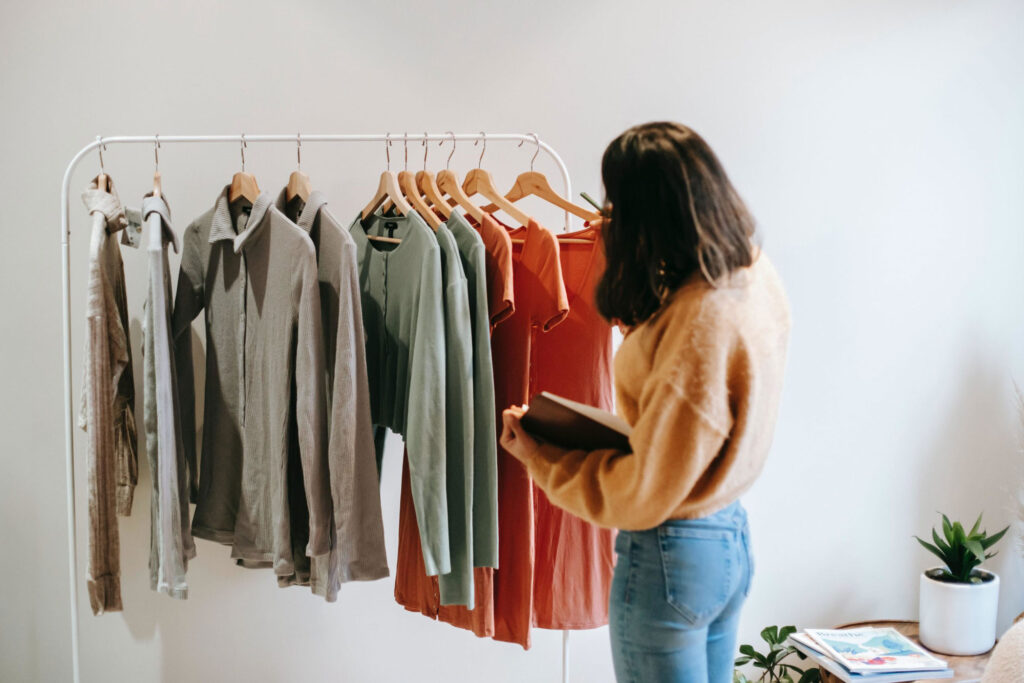
Dear Fashion: Let’s Step Up and Get Aligned
In a recent opinion editorial with WWD, CEO Colin Browne argues fashion needs to take more serious and coordinated action on sustainability. Read the highlights here!
In March, Cascale and Worldly held a webinar, “Navigating Legislation & the Higg Index: Higg Product Tools with PEF and more.” In this blog, we share the recording, highlight key takeaways, and address submitted questions during the session.

Key Takeaways
“The PEF methodology is likely to play an important role in the future EU product and consumer law legislation. The Higg Product Tools methodology is well-positioned for alignment with Product Environmental Footprint (PEF)/PEF Category Rules (PEFCR), and the Higg Product Tools can support members in navigating evolving legislations and provide guidance in their compliance journeys.” –Elisabeth von Reitzenstein, senior director of policy and public affairs
“France has been, and probably will be for the foreseeable future, a frontrunner on sustainability legislation….The French label is based on a type of PEF. It has very strong alignment with the European Product Environmental Footprint principles. One difference on durability is that the French Methodology also includes ‘emotional durability’ to a more committed extent than the European one. This proves again that a common method on PEF is important…Another new French initiative is a draft bill targeting fast fashion and sometimes ultra-fast fashion… Also on the European level, France is fighting its corner on these issues. At a Council of the EU meeting on March 25, it called, alongside Sweden and Denmark, for an EU-wide export ban of hazardous textile waste to developing countries.” – Elisabeth von Reitzenstein, senior director of policy and public affairs
“Through our partnership with Cascale, Worldly is paying close attention to this regulatory landscape and what our customers need in order to prepare and report on their sustainability performance and progress. My team meets at minimum weekly with Cascale to get deep into the weeds on PEF, how it’s evolving, and what it means for our tools and the solutions we’re delivering. The Cascale team also helps us understand the challenges the industry is facing firsthand and ways to address it in the tools. Data is going to play a critical role in many, if not all, of these reporting requirements.” – Paula Bernstein, senior data manager, Worldly
“The concept of accessibility is really key for the Product Tools because we want a variety of users with different levels of LCA knowledge, as well as data availability to produce consistent environmental product footprint results.” – Quinten Geleijnse, manager, Higg Product Tools and lifecycle assessments
“Like the rest of the Higg Index Tools, we don’t want the sole purpose of the tools to be compliance – the tools should be going beyond regulation. We’re not just trying to have a PEF-compliant calculator. That is not ambitious enough to get the industry on track to where it needs to be. [The Higg Index] needs to be aligned with PEF, at minimum for compliance, but we do need to go beyond that.” – Joel Mertens, director, Higg Product Tools
“There are a lot of commonalities between Higg Index Product Tools, PEF, and France’s Ademe methodology but we do expect that even with the same product information, it is very likely you will have different results depending on which methodology you’re calculating to or which region you’re calculating to…One of the important things is while there are differences in the results, the impact categories, the data needs, there is a way to bring this all together, and that is the hub concept.” – Mertens
“One of the key aspects here is the difference between a footprint calculation and a footprint study, or LCA study. Our tools are calculating an environmental footprint of a product. An LCA study is distinct from the footprint calculation. There are additional requirements that have to be done to take you to that full study level, including a report and verification.” – Mertens
“PEF is an implementation of ISO-1440 and 44 standards. There are study requirements associated with that that I think get lost in the narrative. As to other tools in this space, the one thing I will say right now is there is not a final PEFCR for apparel and footwear. There are a lot of claims and misunderstandings as to what you can say in terms of compliance to PEF and PEFCR, and there’s no such thing at this point.” – Mertens
Questions Answered
On the webinar, speakers discussed relevant EU legislation and initiatives, including:
These regulations relate in different ways to the Product Environmental Footprint (PEF) method and product footprinting in general. CSRD requires a thorough assessment of an organization’s impacts, risks, and opportunities, and specifically mentions PEF as a way to assess these. In addition, the calculation of scope 3 emissions is required under ESRS E1, for which LCAs and/or PEF studies are useful. ESPR will likely require environmental impacts to be communicated to external stakeholders through the Digital Product Passport, for which PEF and LCA studies can be used. The European Commission proposal for the SGCD sees a more diminished role for PEF in its current form than initially foreseen. Although PEF might not become a mandatory requirement itself under SGCD, the more simplified procedure now pursued may include a presumption of conformity for environmental claims that are based on recognized methods, such as PEF. The French labeling law is based on calculations obtained from a central database run by Ecobalyse and the Agency for Ecological Transition (ADEME). This method is inspired by PEF but has some noticeable differences.
The PEF category rules (PEFCR) contain specific rules for product categories that complement the PEF methodology. The rules direct focus to the parameters relevant to that specific product group, further standardizing the methodology. The Technical Secretariats (TS) of the EU develop these PEFCRs, and Cascale coordinates the TS developing the PEFCR for Apparel & Footwear, which includes determining the product-specific methodology and primary data requirements. The TS does not determine what secondary datasets are to be used and has to stay in line with the general PEF methodology. The PEFCR is expected to be finalized in Q1 of 2025 and is currently in its consultation phase.
The Higg Product Tools aim to guide product eco-design decisions by providing reliable, high-quality data. Given the legislative developments and the changing data requirements that they cause, the Product Tools should evolve accordingly. Our objective is to develop the Product Tools as a hub that allows different users (with different levels of data availability and LCA knowledge) to compute different types of results for different purposes. This means users can continue to identify impact hotspots and calculate scope 3 emissions, while we expand the tools’ functionalities to allow for PEF calculations. It is important to note that PEF compliance entails more than calculations only as PEF requires an extensive study report that has to be verified by a third party.
Some steps towards PEF-aligned calculations have already been taken by Cascale and Worldly. The current Product Module methodology was developed in alignment with the 2021 version of the PEFCR. This means the Product Tools are already well set up to expand towards PEF-aligned calculations. The team has mapped the key remaining differences between the current Product Tools methodology and emerging regulatory frameworks. This exercise informs Cascale’s product information Member Expert Team (MET) that currently helps define the product-relevant information fields the Product Tools need to contain to align with the data requirements of various frameworks, including PEF, ADEME, and the DPP. As indicated by the workstream flow chart below, Cascale will begin integrating the ADEME and PEF calculation methodologies with the Product Tools when they are finalized. In the meantime, work with the Product Information and Product Impact MET and continue to develop the tools’ hub functionality.

Cascale is working with Wordly to create a harmonized set of information fields for the Product Tools, containing all required information from the different legislative frameworks and distinguishing between mandatory, recommended, and optional data points. This allows users to compute different types of results based on a single set of information and enables the provision of at least some results when limited data is available. Cascale will also expand its current list of five impact categories to the 16 impact categories specified in the PEF methodology. To enable different result types to be computed, different calculation methodologies will have to be integrated into the Product Tools, some of which rely on different datasets than those currently used in the tools. Cascale is working together with Wordly to allow for parallel impact calculations and add these new (EF) datasets to the tools.
Please note that the visual is taken from the webinar slide deck and the timeline reflects the March 27, 2024 webinar date. Depending on when you are viewing this blog post, the visual may be out of date.
Cascale and Worldly are working together to expand the Product Tools to enable users to select the energy mix used to manufacture their products. This will ensure the country or facility-specific energy mix is considered in the calculations, providing more precise impact calculations. A next step will be to connect the Higg Product Tools with the Higg Facility Environmental Module (FEM) to enable the sharing of facility data to be used for product impact calculations.
While many of our members can and are already using the product tools for homeware and home textiles, PEF currently is explicit for “Apparel and Footwear.” The sectors the EU Commission has identified for PEF are the following:
However, the Product Tools may still be used to assess adjacent products such as home textiles. Even our current Product Module tool has an option for an “other” product category, which is being used by some members to assess these types of products.
If you have any remaining questions, we invite you to email us at marcomm@cascale.org.
We are grateful to KPMG for their work in developing this report, which captures the invaluable insights and recommendations derived from the expert review of the Higg MSI and Higg PM tools.



Since our inception in 2009, the Sustainable Apparel Coalition (SAC) has always recognized that sustainability is a multifaceted topic. From an environmental perspective, to social and labor issues at a global scale, there are a multitude of aspects to take into consideration, including: impacts in creating different synthetic and natural raw materials, the manufacturing decisions to convert those raw materials into products, the number of times a product is used to what happens to it at the end of its life, as well as responsible purchasing practices and the conditions in which garment makers work.
Given this complex reality, measuring sustainability can never be narrowed down to one single criterion. We have always advocated that our members, including retailers, brands, manufacturers and affiliates, adopt a broad approach – ensuring production methods, social impacts, and the entire value chain are considered. That’s why our Higg Index suite of tools for measuring sustainability cover topics as varied as water use, carbon emissions, and labor conditions.
In conjunction with industry specialists, our world class team of experts have created this array of tools to measure impacts at every point in a piece of apparel’s life cycle – reflecting real world complexity. Working with experts, our tools continue to evolve with scientific and data developments, alongside of course the needs of our members. They have been developed based on intervention points that we know make a difference to impact, including those that aren’t always directly quantifiable. Here are just some of the subjects they tackle:
Emissions
Reducing greenhouse gas emissions is vital. To achieve net zero and stop global warming from spiraling out-of-control, it’s essential that all manufacturers, retailers, brands, and suppliers urgently decarbonize. The first step in doing so is to measure current emissions. To help our members do this properly, our tools offer a comprehensive approach.
Take our Higg Material Sustainability Index (MSI) as a case in point, which has recently been updated to include more than 20 new materials and processes, making it one of the largest updates that the tool has experienced. Using primary data submitted by our members and other industry players, it assesses the complete cradle-to-grave impacts of different materials, including emissions.
The process data in the Higg MSI uses an LCA approach that factors in all the way to Scope 3 emissions. This includes indirect emissions that may be otherwise hidden from a user, like the energy required to mine resources, and all the manufacturing emissions related to the upstream value chain inputs. To drive collective and urgent action on emissions reduction, we recently launched our Decarbonization Program. It requires all our members to set Science-Based Targets, which provide a clearly defined path to reduce emissions in line with Paris Agreement goals, and we are educating members and sharing best practices on how to set targets and implement them.
Supply Chains
Fashion is a complex global industry, with supply chains criss crossing continents. In this context, true sustainability can only be achieved through collective action. No brand or retailer can do this alone. Each is reliant on multiple suppliers and must bring them on its sustainability journey.
Accordingly, we advise all our members to map out and understand their supply chains, and work with them to develop roadmaps to set targets and drive improvements. This includes decarbonization, reducing water consumption, cutting waste, and ensuring fair pay and conditions for all workers.
To this end, our Higg Facility Environmental Module (FEM) offers insights for manufacturers, brands, and retailers on the environmental performance of individual factories or production facilities. For example, it measures the carbon intensity of their manufacturing processes based on the energy grid mix – in terms of renewables versus fossil fuels – of their geographic location, when that information is available and can be independently validated.
In practice, this means it can show the difference in manufacturing emissions in countries like Indonesia or China, where the energy grids tend to be more fossil-fuel-based, versus somewhere like Europe, where renewables are more common.
From a social perspective, our Higg Facility Social & Labor Module (Higg FSLM) helps to promote safe and fair social and labor conditions for value chain workers all over the world. It offers not only a scoring model eliminating the need for brands to conduct individual audits to assess facilities’ performance, and reduce audit fatigue, but allows businesses to dedicate time and resources to making lasting systemic changes, instead of focusing on compliance.
Product Processing Choices
Fashion brands must also consider how products are made. Different methods result in different emissions and environmental impacts. To keep their carbon footprint to a minimum, companies can compare the scale of emissions generated by different processes using our Higg MSI. To make this comparison possible, we use an industry average in terms of the carbon intensity of the energy grid mix. Once they’ve compared the relative impacts of similar processes, they can then use our Higg FEM to select which factory, in which part of the world, offers the right process in combination with a low-carbon local energy grid mix.
Different Fabrics
Raw materials are significant, although sometimes their importance can be overestimated. The reality is that they are just one part of the picture. Using impact data from the Higg MSI, the World Resources Institute and Apparel Impact Institute released a report which revealed that raw materials only account for roughly a quarter of the impact of manufacturing a product – even before including use or end of life.
The nature of a fabric – whether or not it is natural, synthetic, organic, or recycled – is not the predominant issue in how sustainable it is, as the interventions highlighted from that report show.
Indeed, data from our Higg MSI shows that simply switching fibers often doesn’t result in any meaningful reduction in a garment’s carbon footprint. Other factors – like the emissions embedded in its production – tend to be more influential. These choices also tend to have less effect on the functionality of a product. A design brief often specifies the type of material that should be used, since this changes the function of a product. Polyester t-shirts and cotton t-shirts are different. But the decision to dye a fabric in a conventional way or to use a lower impact method isn’t something that’s typically specified in a product brief and is something that can be influenced directly.
Wears Per Garment
Poorly designed clothing is clearly less sustainable than high quality garments that are loved and used for years on end. We believe it’s crucial that the quality and longevity of a brand’s products are assessed as part of their sustainability ranking. Our Higg Product Module (PM) measures the cradle-to-grave environmental impacts of a product from the point of resource extraction to manufacturing impacts, all the way through product durability, care, and end of use. The default reporting metric of the Higg PM considers both the total footprint of the product and how long it will be used for (wears per garment), and we’ve continued to advocate and support this ‘impact per wear’ approach as part of our role in developing the PEFCR Technical Secretariat.
True Sustainability
An umbrella term covering a series of interlinked issues, sustainability is multifaceted. Sometimes, addressing one requires trade offs elsewhere. The key is to analyze the most scientifically accurate data in every area and then create a comprehensive plan. There are seldom simple fixes.
But we must not let the scale of the challenge daunt us. The fashion world is packed full of extraordinary talent. We have the tools, skills, creativity, and capability to embark on this collective journey of self-improvement. When it comes to protecting both people and the planet, we should always aspire to be better. In practice, this means taking a broad approach.


With 2023 already in full swing, I wanted to take a minute to provide a quick update on where we are with the Higg Index Review, a process I know many of you, our members and external stakeholders, are keen to learn more about. With the process now underway, this blog highlights exactly where we are now and next steps.
As many of you will be aware, the last comprehensive review of the Higg Index was back in 2017. This saw approximately two dozen independent academics examine the methodology and workings of the MSI tool and provide their recommendations for further strengthening and development. Five years on, as we announced towards the end of last year, we’re seeking further expert guidance to inform the next phase of the Higg Index evolution.
Of course, it is important to be clear that the full suite of tools is still very much active and available to all users. The review is being carried out to ensure continuous improvement, the context in which the tools are used continues to evolve, and with it so must the tools. This is true of almost any system, database, or tool for measurement. We are committed to ongoing improvement to help ensure we are providing the industry with the strongest tools available to enable social and environmental change.
The review we have committed to is comprehensive. We are working with KPMG to coordinate the project, including recruitment of three panels of independent experts. There will be a panel for the FEM review, one for the BRM, and another for the MSI and Product Module. Each of these panels will be made up of approximately ten independent professionals with a cross-section of expertise and background. This will include technical and environmental specialists, academics and representatives from civil society. None of the individuals will be from member organizations and none will have previously worked on the Higg Index tools.
With this rigor comes additional challenges – if we were seeking a single expert partner organization to carry out the review, the recruitment, management and timelines would be significantly streamlined. However, a rapid recruit and review would not provide the depth of examination we are seeking.
Once the recruitment of the panels is finalized, the review process will take approximately eleven weeks. This will include briefing and preparation of all individuals, a Q&A phase for panelists to come back with specific points and clarifications, the review and evaluation itself, and then the creation of the report. We predict that each panelist will provide in the region of 50 hours to the review. While dates remain fluid as recruitment is finalized, we hope that SAC will receive the comprehensive report and recommendations in June 2023.
Once received, and in the spirit of transparency, we will publish the report in full for members, stakeholders and interested parties from our industry and beyond to read. It’s at this point that we will take stock of what action to take forward, how and when.
While we remain hopeful for validation that the underpinning MSI and PM methodology is in line with ISO14040, the standard addressing quantitative methods for assessment of environmental aspects of a product or service in its life-cycle, one area we expect to be highlighted in the report is the need for ever evolving data. This is where there could be potential for updates to the MSI and Product Module tools in the form of additional impact categories and shows where and how the world has moved on since the last review – for example, there are five impact categories at the moment and, in comparison, the hoped-for PEF from the European Commission has 16. We hope the review will help to identify data gaps to prioritize, and we can use this insight to further encourage the industry to step up and provide continuously stronger and independently verified LCA data to lock into the tools.
The review is independent, comprehensive, and an indication of the commitment SAC has to ensuring the Higg Index tools continue to play a crucial role in improving the fashion and apparel industry and in reducing its negative impact the planet and its people.
We will provide further updates as the process develops.
Learn more about the business value and benefits of the Higg Index.
